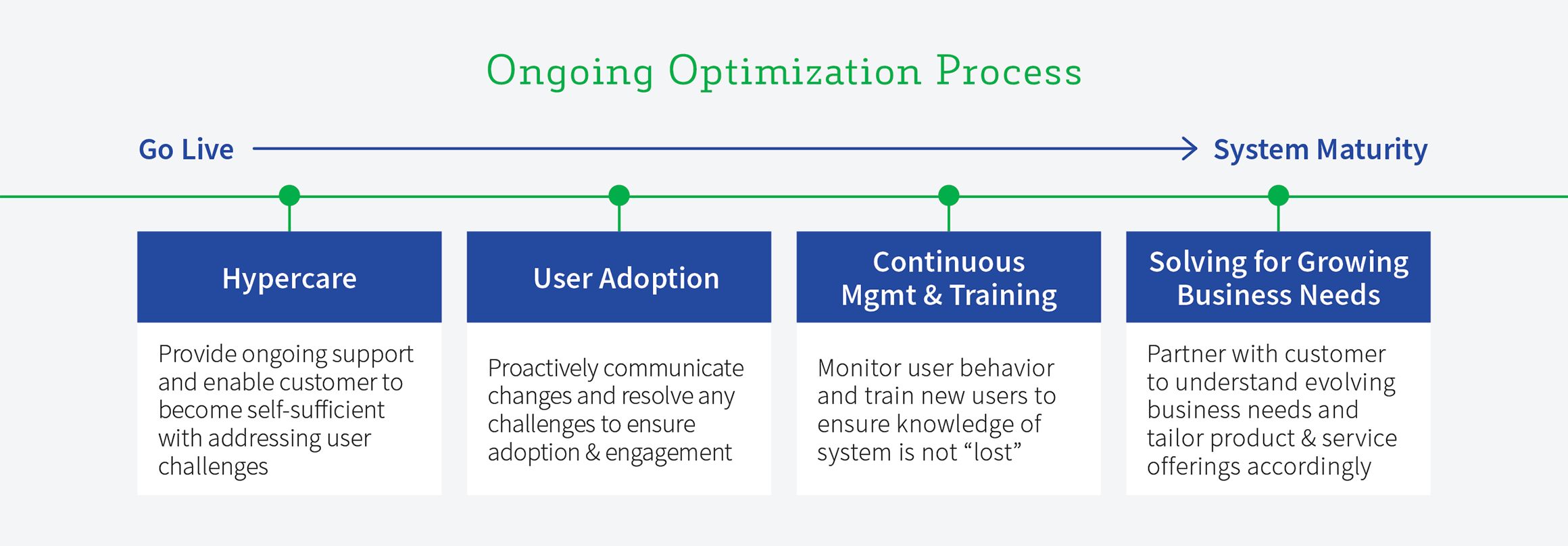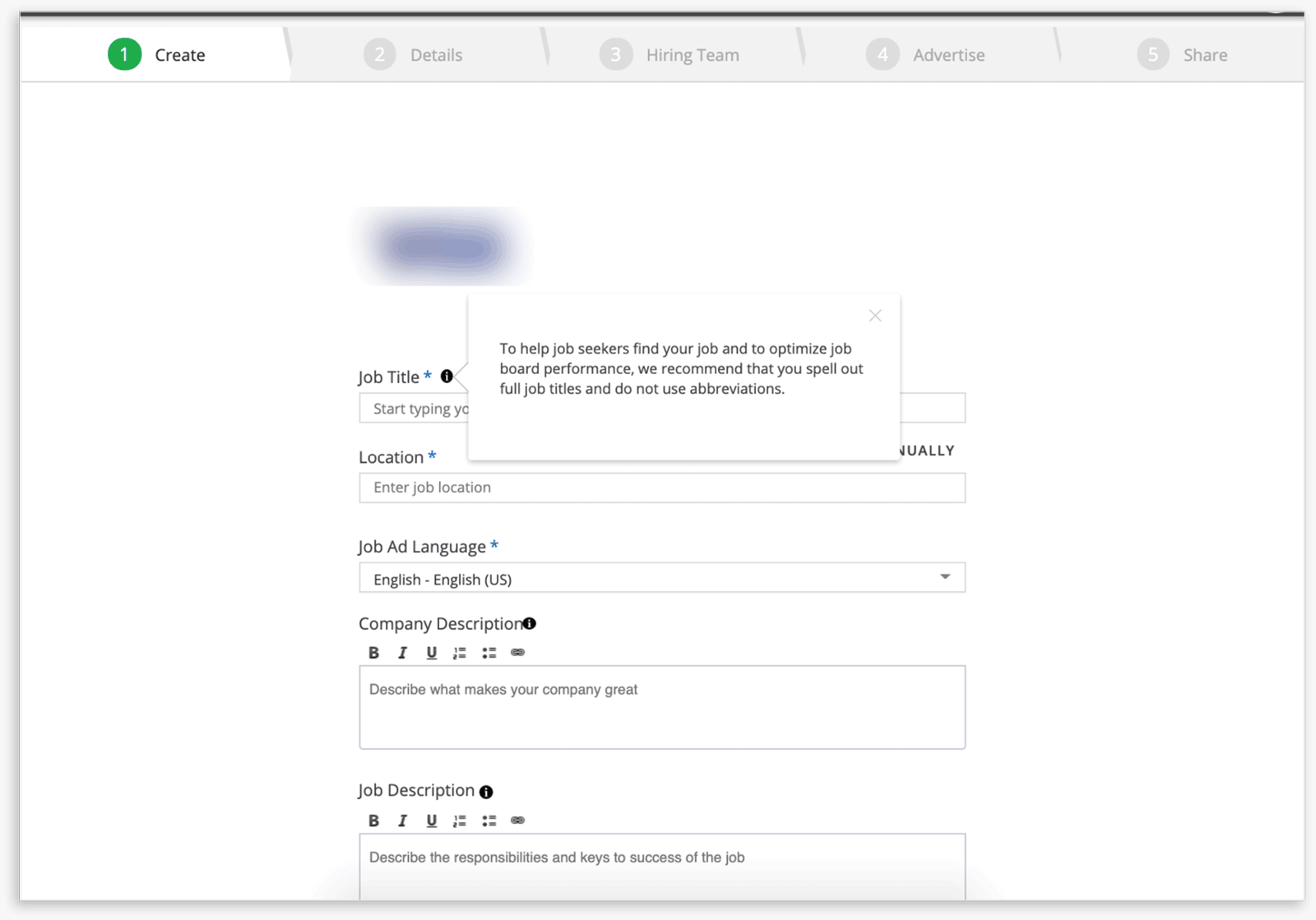Continue Reading
Ongoing Engagement
You’ll know that your project has been successfully carried out if your new recruiting platform is widely adopted. This is fundamentally important to maximizing the return on your investment. However, your journey does not stop there.
In order to ensure that technology investments continue to support your business over time as it evolves, it’s important to maintain a close relationship with your provider. Ideally, they should proactively keep your company’s objectives in mind.
In the short-term, you’ll want to plan for an extended period of initial support from your provider in the event that any issues arise. In the long-run, your aims should be maintaining strong user adoption, training new employees, and identifying opportunities as your business develops.

Hypercare
After successfully launching a new system, providers typically engage in a 1–5 week period of support known as Hypercare. During this time, the implementation team allocates resources to help customers as they get started. The goal is to not only provide support, but also help users become proficient and self-sufficient. For example, one of the priorities during this period should be educating users whom to ask (e.g. system champions) for assistance, or where to go for information (e.g. help center) in case of any issues or challenges.
User Adoption
To make the most of your technology, it’s important that all intended users actually engage with it. When users turn to external products or systems for a solution, it hinders your ability to accurately collect and report upon valuable data. This negatively affects the quality of your team’s work, as well your ROI. Below is an example of a company that was able to effectively plan and communicate a strong user adoption program.
Hiring Success in Action User Adoption Done Well
A San Francisco-based digital experimentation and analytics company knew that prioritizing user adoption was critical to a successful implementation of their new ATS solution. The company began by organizing and aligning their internal team with their technology provider’s team across goals, roles, and responsibilities. This made the internal team aware of, among other things, the required job fields, processes, and reporting structures that needed to be configured in the new system. They followed up with a comprehensive timeline that included regular check-ins to gather feedback from various stakeholders and evaluate overall progress.
As part of their project timeline, the company included a DRIP (Differentiate, Reinforce, Inform, Persuade) communication framework and plan to ensure that all key users were informed of the oncoming changes. The consistent and regular engagement from the DRIP campaign was instrumental in aligning user expectations and pushing them across the change curve of the system, ultimately leading to strong adoption.
As a result, the company’s average time to enter a review for candidates went from 2.5 days in January 2019 to 1.0 days in April 2019—a 60% improvement in just four months.
| Milestone | Tactic |
|---|---|
| 6 Months Prior to Launch | Company-wide announcement that a switch to a new system is coming with a summary of how this new system would improve workflows & efficiency |
| 3 Months Prior to Launch | Update with illustrative visuals shared to build hype & excitement |
| <3 Months to Launch | Periodic check-ins schedules to inform key users of progress being made |
| Go-Live | Standard communication templates & training materials distributed to ensure key stakeholders were aware of the new system, how to use it, and who to reach out to in case of any queries. |
Continuous Management and Training
Following the hypercare period, we encourage customers to maintain an ongoing relationship with their technology provider. This ensures continuous adoption and engagement with the system. Ongoing partnership is especially vital for recruiting technology given relatively high turnover rates among recruiters. Many of the original users who were present during the implementation phase may no longer be with the company six months to 1 year post-launch.
If the customer relationship is not proactively managed following launch, user adoption of the system can drop significantly and result in reduced productivity.
At SmartRecrutiers, we staff Customer Success Managers (CSMs) to manage the business relations between the customer and the provider following the implementation process and “go-live.”
The first step is to partner with CSMs to regularly track user activity and identify any potential red flags. Our CSM teams at SmartRecruiters closely monitor key SaaS metrics such as: number of active users and average time spent on system, NPS, CSAT, etc. However, they also measure metrics that are more insightful to your recruiting technology and team’s success. Some of these include:
Does your organization actually use SmartRecruiters for their recruiting activities?
(Can be segmented by location, function, or even recruiter).
Are your hiring managers & hiring teams able and willing to use your technology to rate candidates?
Are non-traditional users (e.g., non-recruiters) comfortable using the system?
(This metric is also a good indicator of overall company health).
Tracking these recruiting-specific metrics informs CSMs, as well as your organization, how the product is being perceived and used. With this insight, CSMs can work with you to tailor a custom strategy for any challenges that may arise.
Another key strategy is to leverage CSMs to maintain ongoing training, especially for new employees. According to SHRM, companies see an average annual turnover rate of 18%. For large enterprises with 10,000+ FTEs, that’s an additional 1,800 new employees (at least) to train on a new system. This is why we strongly recommend annual training sessions with our professional services team.
The curriculum includes basic user training, best practices, and updates from the latest product releases. This process will help keep your organization’s employees engaged with your recruiting technology years after launch.
Pro Tips
Embedding key feature callouts within the product can reinforce best practices and further engage users while they work. For example, SmartRecruiters allows system admins to create customized, in-product tool tips that notify and educate other team members of a particular feature or functionality (see below).

Solving for Growing Business Needs
Finally, one of the biggest responsibilities for recruiting technology providers is to align talent acquisition with business success. At SmartRecruiters, we entrust our CSMs to proactively work with you on understanding and addressing your business challenges and opportunities. We do this through regular check-ins, quarterly business reviews to go over scorecards and metrics, and annual account planning workshops. This partnership enables you to use your tools and resources properly to ensure a well-oiled TA machine.
At the same time, as your business grows, your CSMs should be leveraged as strategic advisors who can guide you on how to adapt. They should regularly keep track of user growth and work with you on which solution(s) can best help you scale accordingly. This may involve updates to current technology or other services such as business audits, process innovation, re-configuration, integrations with partner networks, etc. At SmartRecruiters, we pride ourselves in our ability to provide these services through our Hiring Success team.
For example, new leadership may decide to implement changes in strategy, systems, and/or processes related to HR & TA. In these cases, it’s best to understand how your current technology can help you achieve this vision together. CSMs should be able to guide you in identifying which solutions will work best for you.
Hiring Success in Action Hiring Velocity Improvements via Ongoing Engagement
A leading construction formwork company invested in both SmartRecruiters technology and partnership. Our CSM team met with TA management on a regular basis to present the latest product releases and review best practices while TA managers shared updates related to hiring strategy and processes, as well as current satisfaction with the system. TA managers then distilled all updates and shared relevant information with their TA community during a monthly huddle.
This engagement was useful for both the customer and the provider. The company’s TA team was able to learn more about new and relevant product capabilities. At the same time, SmartRecruiters CSMs were able to better understand the nature of the customers relationship to the product, allowing CSMs to tailor product offerings and services that appropriately catered to their customer’s needs. Consequently, the company was able to maintain strong adoption and engagement across 160 branches, 70 countries, and 6,700 full-time employees.
Strong buy-in from recruiters and hiring managers, in addition to an increase in higher-skilled candidates, saw the company’s Hiring Velocity improve by 37%.
Time from post to hire
Application to hire rate
Jobs filled on time
Hiring Success in Action Ongoing Engagement Blunders
Our CSMs have also experienced situations where organizations did not engage with their providers on a regular basis. This lack of engagement almost always hurts businesses’ ability to attract quality talent. For example, a global media and advertising company purchased a new ATS with the hopes of becoming more competitive in talent attraction. After a successful launch, the company saw an initial uptick in user adoption and engagement, which led to an improved candidate experience and higher quality hires.
Unfortunately, the company did not create standard operating procedures to maintain an ongoing relationship with their technology provider, preventing them from tracking user adoption, engagement, and satisfaction over time, particularly during employee turnover. In addition, there was no formal process for knowledge sharing—training new users or educating about new product updates.
As time went on, more and more original system users left the company, creating a knowledge gap. The company eventually “forgot” how to use the product and fell behind on the latest features. A few years later, the organization changed systems due to stalled performance in talent attraction. Had the company engaged with their CSMs to voice concerns and challenges, they may have been able to flag these issues earlier. This would have saved the company time, money, and the hassle of evaluating and implementing a whole new system.
As one CSM mentioned, “In instances like these, the product usually offers all the capabilities that the organization is looking for. Unfortunately, the users may not know that because the people who actually know how to use the system have all left, and those remaining were never properly trained on it.”